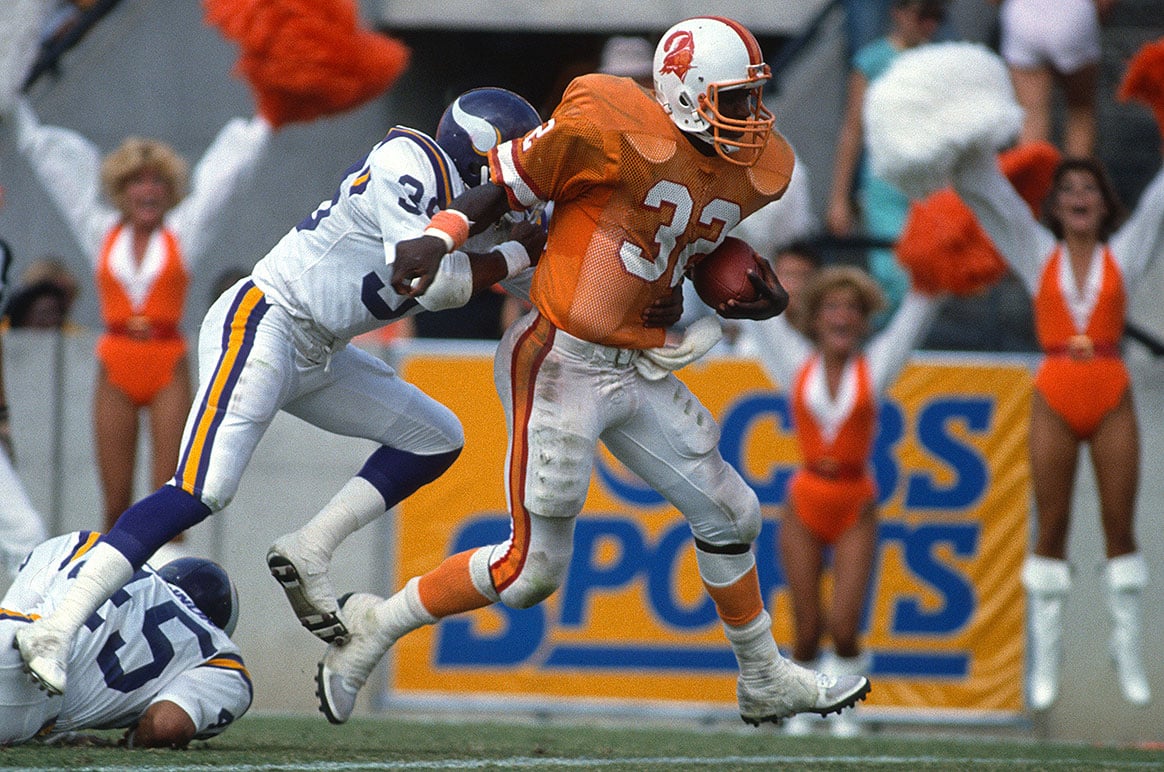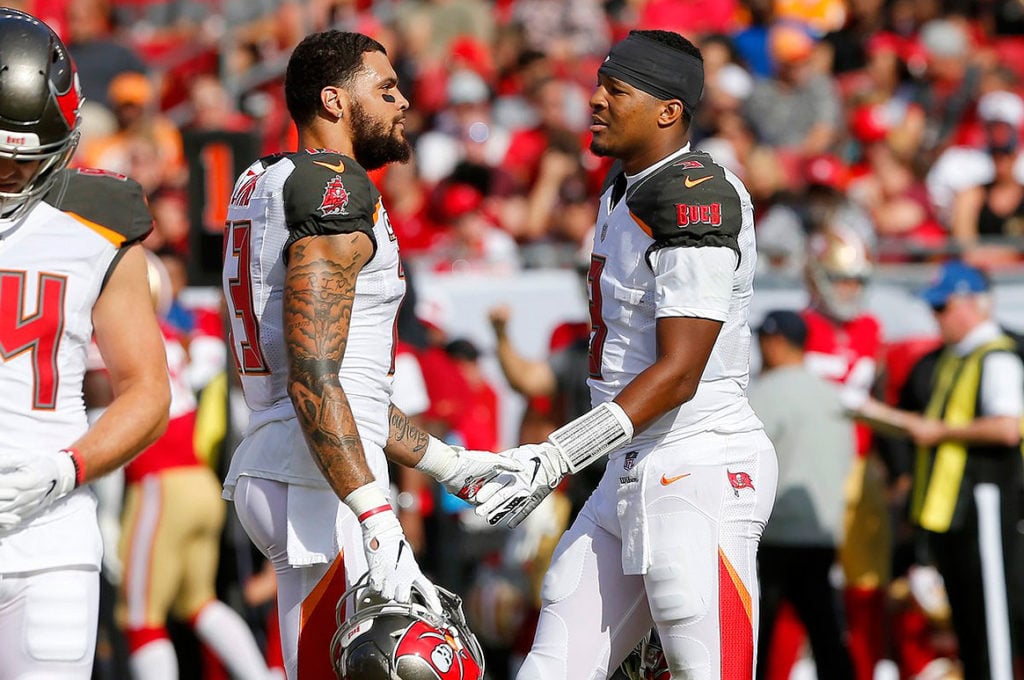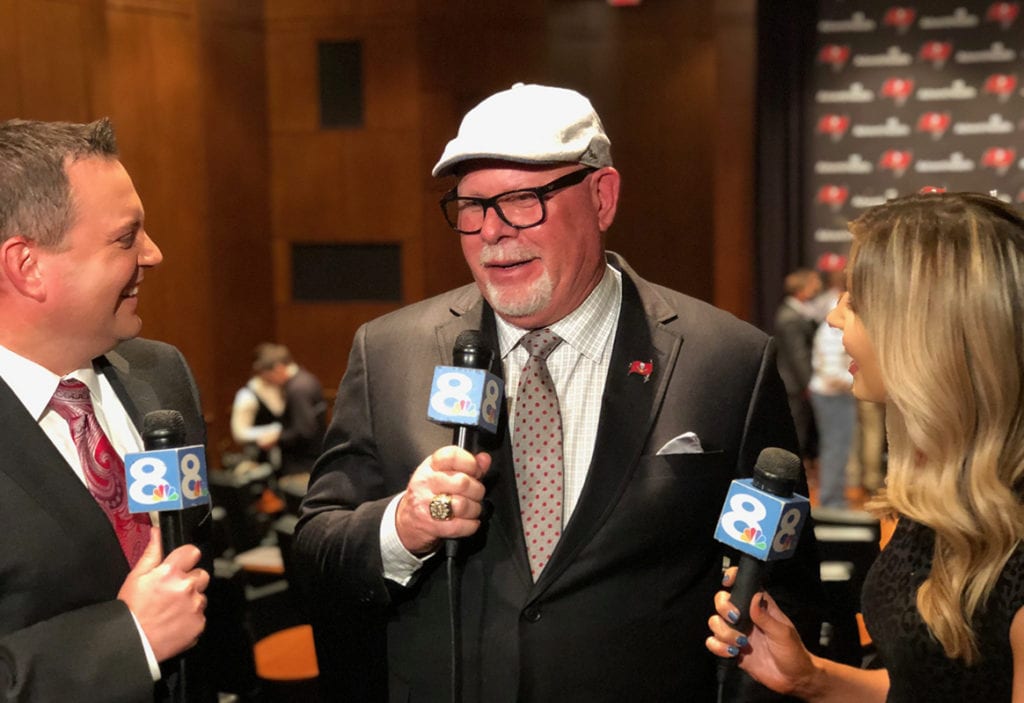The Tampa Bay Buccaneers will be announcing their 2019 Bucs Ring of Honor member or members soon. The next most decorated and deserving member should be legendary cornerback Ronde Barber, who is the franchise’s all-time interception leader with 47 and was a five-time Pro Bowler.
Barber, who made the greatest play in Tampa Bay history, returning a Donovan McNabb interception 92 yards for a touchdown to clinch a trip to Super Bowl XXXVII, played 16 years in red and pewter, which was longer than any other Buccaneer in team history. If it’s not Barber to follow strong safety John Lynch, who was last year’s inductee, then something is wrong with the Glazers’ induction process to the Bucs Ring of Honor.
Yet there are plenty of other worthwhile candidates. The PewterReport.com staff explored some of the other former Buccaneers that deserve consideration in a recent PR Roundtable. Those names included defensive end Simeon Rice, middle linebacker Hardy Nickerson former defensive coordinator Monte Kiffin and running back James Wilder.
On Sunday, Wilder’s son, James Wilder, Jr., chimed in on the debate on Twitter and tweeted at PewterReport.com and the team, imploring the franchise to induct his father into the Bucs Ring of Honor. Wilder, Jr. is a Tampa native who starred at Plant High School before winning a national championship with Jameis Winston at Florida State prior to stints with the Cincinnati Bengals and Buffalo Bills. Wilder, Jr. is now a running back with the Toronto Argonauts in the CFL.
Dear @Buccaneers @PewterReport he leads your team in rushing AND receiving and been holding MULTIPLE records for 30 years now longer than I been alive. PLEASE PUT SOME RESPECT ON HIS NAME AND LET HIM IN!!!#getWILDER pic.twitter.com/RnCUDaHYYo
— James Wilder Jr (@IAm_Wilder32) March 31, 2019
Wilder Jr.’s tweet has been retweeted over 100 times and liked 700 times by Bucs fans. So in the spirit of his father’s accomplishments in Tampa Bay and with the Bucs soon announcing this year’s inductee or inductees into their Ring of Honor, I decided to re-publish a previous column I wrote on Wilder to educate some of the younger fans about a Tampa Bay legend.
I profiled Wilder’s illustrious career in orange and white in an SR’s Fab 5 column on James Wilder back in 2017. Here is that column on Wilder from that edition of SR’s Fab 5, edited only with some updated statistics.
Wilder Was Bucs’ Ultimate Weapon
It’s hard to believe that at age 24, Jameis Winston became the Buccaneers’ all-time career passing touchdown leader last year, surpassing Josh Freeman (80) with 88 by the end of his fourth season in Tampa Bay.
What’s even harder to believe is that some of the records former Bucs running back James Wilder set over 30 years ago still stand today. Wilder, who wore No. 32 in orange and white, was the greatest Tampa Bay player you might not remember.
PewterReport.com named Wilder the 10th Greatest All-Time Buccaneer because after three decades since he last carried the ball, Wilder remains Tampa Bay’s all-time leading rusher and receiver in terms of catches.
And it’s not even close.

Wilder, who played for the Bucs from 1981-89, rushed for 5,957 yards and 37 touchdowns on 1,575 carries, and caught 430 passes for 3,492 yards and nine touchdowns. That’s 869 more rushing yards than Mike Alstott (5,088) ran for his is 11-year Bucs career.
Wilder’s career rushing touchdown record of 37 stood for 12 years until Alstott broke it in 2001.
For decades, Wilder was 109 catches ahead of Mark Carrier, who had 321 in his career and ranks second on Tampa Bay’s all-time receptions list. Wilder’s 30-year career receptions record of 430 will only stand for a few more months until Mike Evans (395) breaks it in 2019, provided the 25-year old receiver stays healthy.
But what a testament to the big running back to carry that receiving record for three decades without it being broken.
Wilder had a franchise-record 14 100-yard rushing games and three 100-yard games as a receiving threat out of the backfield.
The Bucs have had five running backs rush for 1,000 yards – Reggie Cobb, Errict Rhett, Warrick Dunn, Carnell “Cadillac” Williams and Doug Martin – in team history, but Wilder was the first to have two 1,000-yard seasons and the first to do so in back-to-back years in 1984 and ’85.
Wilder also has plenty of other Tampa Bay records that still stand until this day, including:
Most career rushing attempts by a running back: 1,575 – 1981-89
Most rushing yards by a running back in a single season: 1,544 – 1984
Most carries by a running back in a single season: 407 – 1984
Most rushing touchdowns in a season: 13 – 1984
Most TDs by a non-quarterback in a season: 13 – 1984
Most touchdowns in a two-year period: 23 – 1984-85
Most receptions by a running back in a single season: 85 – 1984
Most receiving yards by a running back in a single season: 675 – 1984
Most total offensive yards by a Buccaneer in a single season: 2,229 – 1984
Most career total offensive yards by a Buccaneer: 9,449 yards – 1981-89
Wilder also set a record for most receptions in a game by a Buccaneer with 13 against Minnesota on September 15, 1985. That record was later tied by Earnest Graham in 2007.
During his six years in Tampa Bay, Martin came close to breaking a few of Wilder’s records. He had 11 rushing touchdowns and one receiving score as a rookie in 2012. Martin finished three rushing touchdowns shy of breaking Wilder’s single season mark, and he was two TDs short of breaking his single-season record for most touchdowns by a non-quarterback in a single season.
Martin rushed for 1,454 yards during his Pro Bowl rookie season, but came up 91 yards short of Wilder’s single season Bucs rushing record. Martin was 143 yards shy of beating it again in 2015 when he ran for 1,402 yards. Martin’s total of 1,926 all-purpose yards was also 303 yards shy of Wilder’s total of 2,229 combined rushing and receiving yards in 1984.
One day there will be another Bucs rusher that will topple Wilder from the ranks as the franchise’s leading rusher, but will any Tampa Bay player surpass him in terms of the all-purpose yardage leader? Martin ended his Tampa Bay career with 5,724 total yards, but finished fourth, well behind Mike Alstott (7,372 total yards), Warrick Dunn (7,690 total yards) and Wilder.
The best bet to break that mark might be the 25-year old Evans, who has 6,103 yards receiving. Yet Evans may need three more 1,200-yard seasons would do it.

Wilder was Tampa Bay’s one-of-a-kind back in more ways than one. At 6-foot-3, 225 pounds, Wilder was Eddie George seven years before George entered the league. Wilder had size, speed, tackle-breaking ability, elusiveness and great hands. Here are some rare video clips of Wilder in action, courtesy of BucPower.com’s Paul Stewart:
www.bucpower.com/wilder-chi82.mp4
www.bucpower.com/wilder-gb84a.mp4
www.bucpower.com/wilder-mia82.mp4
www.bucpower.com/wilder-sd81.mp4
Perhaps the best modern day comparison would be comparing Arizona Pro Bowl running back David Johnson to Wilder. In his second NFL season, Johnson rushed for 1,239 yards and 16 touchdowns on 293 carries (4.2 avg.) and caught 80 passes for 879 yards and four more touchdowns. That’s over 2,000 total yards and 20 touchdowns.
Those stats rival the kind Wilder put up in a record-setting 1984 campaign as Tampa Bay’s primary weapon. After rushing for 640 yards and four touchdowns and catching 57 passes for 380 yards and two more touchdowns in his third season with the Bucs as a fullback, Wilder burst onto the scene with 1,544 yards rushing and 13 touchdowns on 407 carries along with 85 catches for 685 yards – all franchise records – after moving to halfback full-time.
In Wilder’s second game at halfback in 1983 he carried the ball 42 times for 126 yards in a 17-12 loss at Pittsburgh. Wilder would rush for 219 yards the following week, validating head coach John McKay’s decision to give him the ball more often.
“He’s the ultimate weapon,” McKay said, as reported by the Tales From The Bucs Sideline book. “Unfortunately, he’s also our only weapon.”
Wilder had 43 carries for 172 yards and a touchdown with four catches for 44 yards in a 30-27 overtime win against Green Bay that year, and 30 carries for 146 yards and two touchdowns with four catches for 46 yards in a heartbreaking 27-24 loss at Minnesota. Wilder had 20 carries for 77 yards and two touchdowns along with 10 catches for 80 yards in a 34-33 crushing loss to the Los Angeles Rams in which the Bucs blew a 26-17 lead in the fourth quarter.
After a 17-14 loss against the New York Giants in which Wilder amassed 177 total yards and a touchdown, Hall of Fame linebacker Lawrence Taylor called him the greatest running back he’d ever faced. Giants head coach Bill Parcells said: “I was impressed. I’d never see him before in person, and I’m not sure I care to see him again.”

A scheduling quirk did put the Giants on the Bucs’ schedule twice that year. Tampa Bay got revenge in Week 11, beating playoff-bound New York, 20-17, behind Wilder’s 99 yards rushing and one touchdown on 34 carries.
Wilder would finish the 1984 season with five 100-yard rushing games as Tampa Bay wound up 6-10. But the Bucs had seven losses by a touchdown or less, including one at San Francisco, 24-17, against the eventual Super Bowl champions.
Three of those defeats were by three points or less. That’s how close Wilder was to leading the Bucs to a 9-7 season – and perhaps the playoffs – in McKay’s final year as Tampa Bay’s head coach.
Wilder made the Pro Bowl that season despite being a marked man in 1984. The Bucs had Steve DeBerg at quarterback with Kevin House and Gerald Carter at wide receiver, along with Jerry Bell and an aging Jimmie Giles at tight end, but Wilder was the star of Tampa Bay’s show. Of the 450 carries by Bucs running backs that season, Wilder had 407 of them.
To say that Wilder was a workhorse would be an understatement. He rarely left the field, and between 407 carries and 85 receptions, Wilder totaled 492 touches on offense that season – yet another Buccaneer record that won’t be broken anytime soon.
What’s even more impressive is that the Bucs offensive line that was blocking for Wilder was average at best. Center Steve Wilson was decent, but turned 30 that year. Gene Sanders and Ron Heller were the tackles, and Steve Courson and Sean Farrell were the guards.
Wilder didn’t have a Tony Mayberry, a Davin Joseph, a Paul Gruber or even an Ali Marpet or a Demar Dotson blocking for him back then. But imagine how many more yards he would have produced if he had?
Imagine if McKay was wise enough to start Wilder at halfback for the first three years instead of making him a fullback and splitting carries among forgettable names like Jerry Eckwood, James Owens and Mel Carver in addition to Wilder?
After all, Wilder set the franchise record for most rushing yards in a game and most total yards in a game on November 6, 1983 when he rushed for 219 yards and had 20 receiving yards that totaled 239 yards. That Bucs record would stand for close to three decades until Martin rushed for 251 yards at Oakland on November 4, 2012 and totaled 272 yards when you factor in his 21 receiving yards. Wilder was the first Buccaneer to rush for 200 yards or more in a regular season game.
Wilder had a good follow-up season in 1985 with 1,300 yards and 10 touchdowns on 365 carries, along with 53 catches for 341 yards. Wilder’s combined 1,641 yards that season ranks fourth in team history. However, McKay retired from coaching after the ’84 season and turned the reins over to Leeman Bennett, who was a disaster and presided over a 2-14 season in ’85.

Wilder’s bright spot that year was rushing for 166 yards and a touchdown on 27 carries against the vaunted ’85 Bears defense. He started the season with four straight 100-yard games and finished with five that season, which tied his franchise record. Wilder narrowly missed rushing for 100 yards or more in four other games, rushing for 92 yards or more in those contests.
After another 2-14 season by Bennett, the Bucs hired former Alabama head coach Ray Perkins, who lost 11 games in each of his three full seasons in Tampa Bay. Those 910 touches between 1984-85 took their toll as Wilder’s production diminished each year. In 1986, he rushed for 704 yards and two touchdowns while catching 43 passes for 326 yards and one score.
Perkins moved Wilder back to fullback in 1987 where he rushed for 488 yards but didn’t have a rushing touchdown for the first time in his career. He did having a receiving touchdown as one of his 40 catches for 328 yards. From 1988-89, Wilder totaled 587 yards and one touchdown on the ground and 51 catches for 459 yards and three touchdowns through the air.
Although he star was fading, the team-oriented Wilder volunteered to play special teams in his twilight years in Tampa Bay. He was that team-oriented as a football player with the Buccaneers.
Yet eager to win after seven consecutive losing seasons, Wilder chose to leave Tampa Bay in 1990 as a Plan B free agent, signing with Detroit. Wilder only had 51 yards rushing with the Lions, but it was enough to give him 6,008 for his NFL career. His last touchdown came on an 8-yard reception – his only catch of the 1990 season. Wilder retired after the 1990 season, following a 10-year NFL career.
“When you say, ‘Tampa Bay,’ you should say ‘James Wilder’ in the same sentence,” linebacker Ervin Randle was quoted as saying after his departure in the book Tales From The Bucs Sideline. “He never got a lot of credit over the years, but he’s always been the same happy guy, willing to give it all. You’ve got to respect a guy like that.”
After reviewing his accomplishments, Wilder deserves the utmost respect. After having several of his Tampa Bay records stand for 30 years, Wilder eventually deserves to have his name listed in the Buccaneers Ring of Honor.
For a further look at Wilder’s abilities, here is the John McKay Show following Tampa Bay’s win at Minnesota in 1983 where Wilder rushed for a team-record 219 yards and two touchdowns. Wilder’s runs are at 6:16, 7:12 and 8:20.
Scott Reynolds is in his 30th year of covering the Tampa Bay Buccaneers as the vice president, publisher and senior Bucs beat writer for PewterReport.com. Author of the popular SR's Fab 5 column on Fridays, Reynolds oversees web development and forges marketing partnerships for PewterReport.com in addition to his editorial duties. A graduate of Kansas State University in 1995, Reynolds spent six years giving back to the community as the defensive coordinator/defensive line coach for his sons' Pop Warner team, the South Pasco Predators. Reynolds can be reached at: [email protected]




